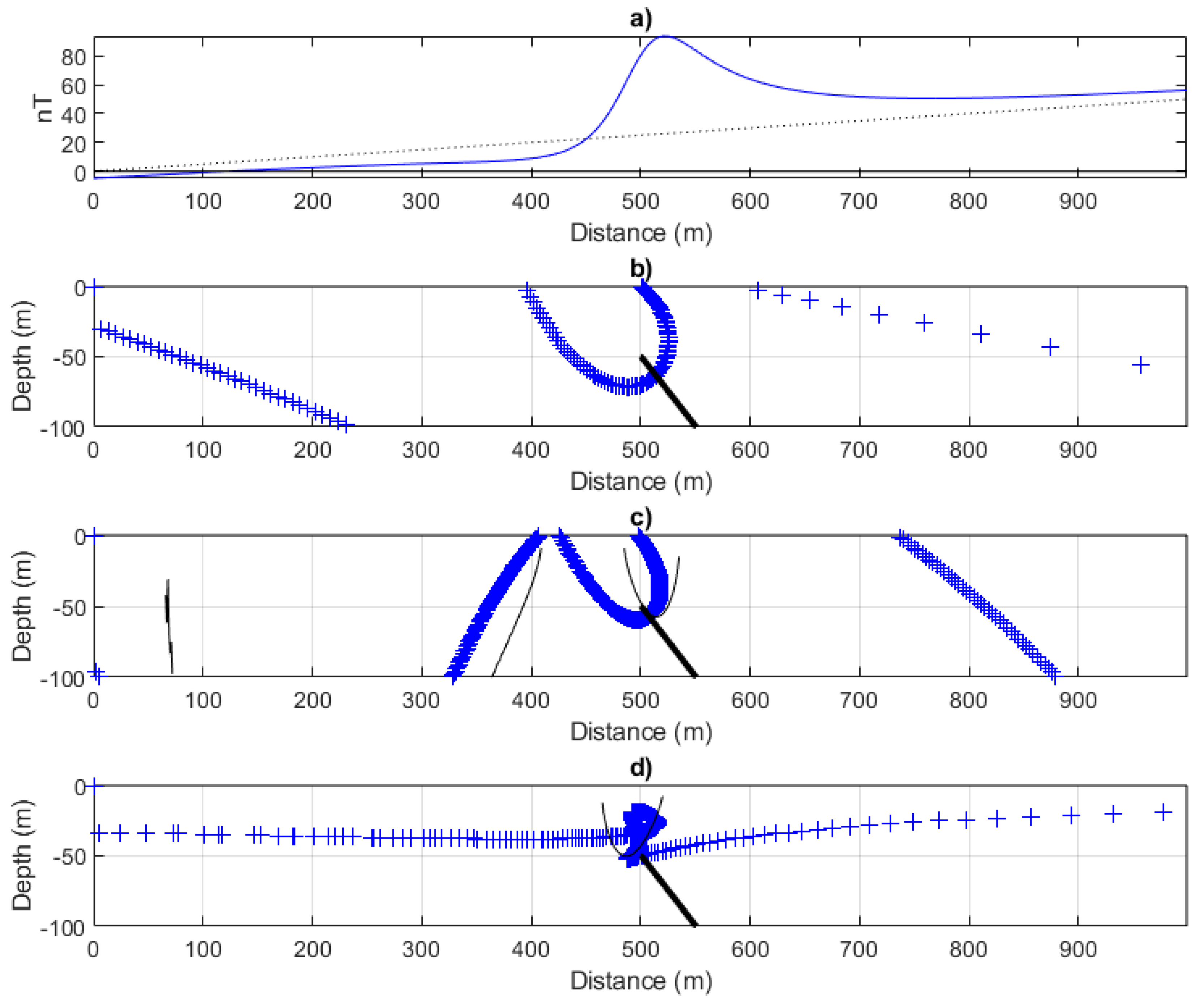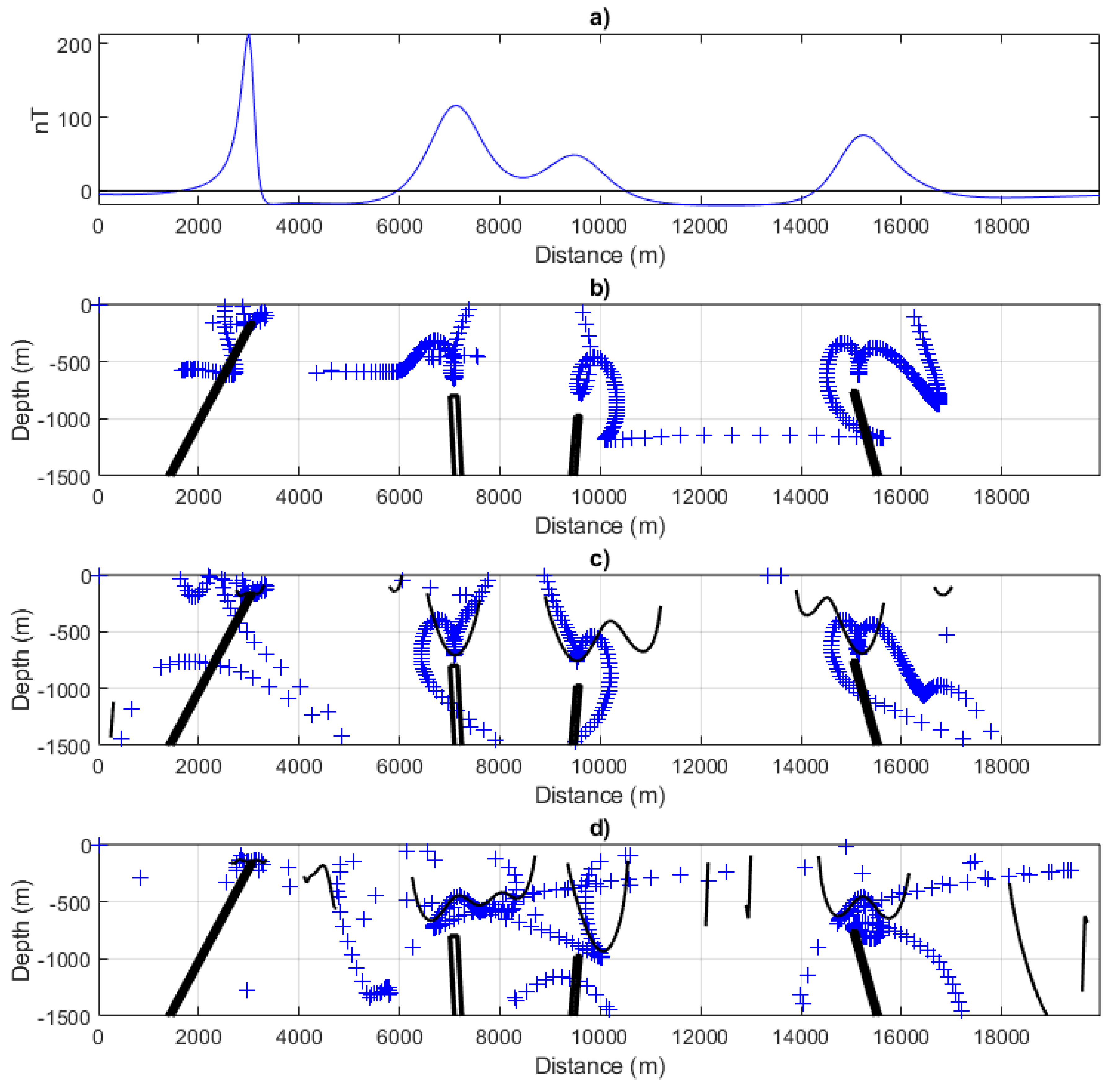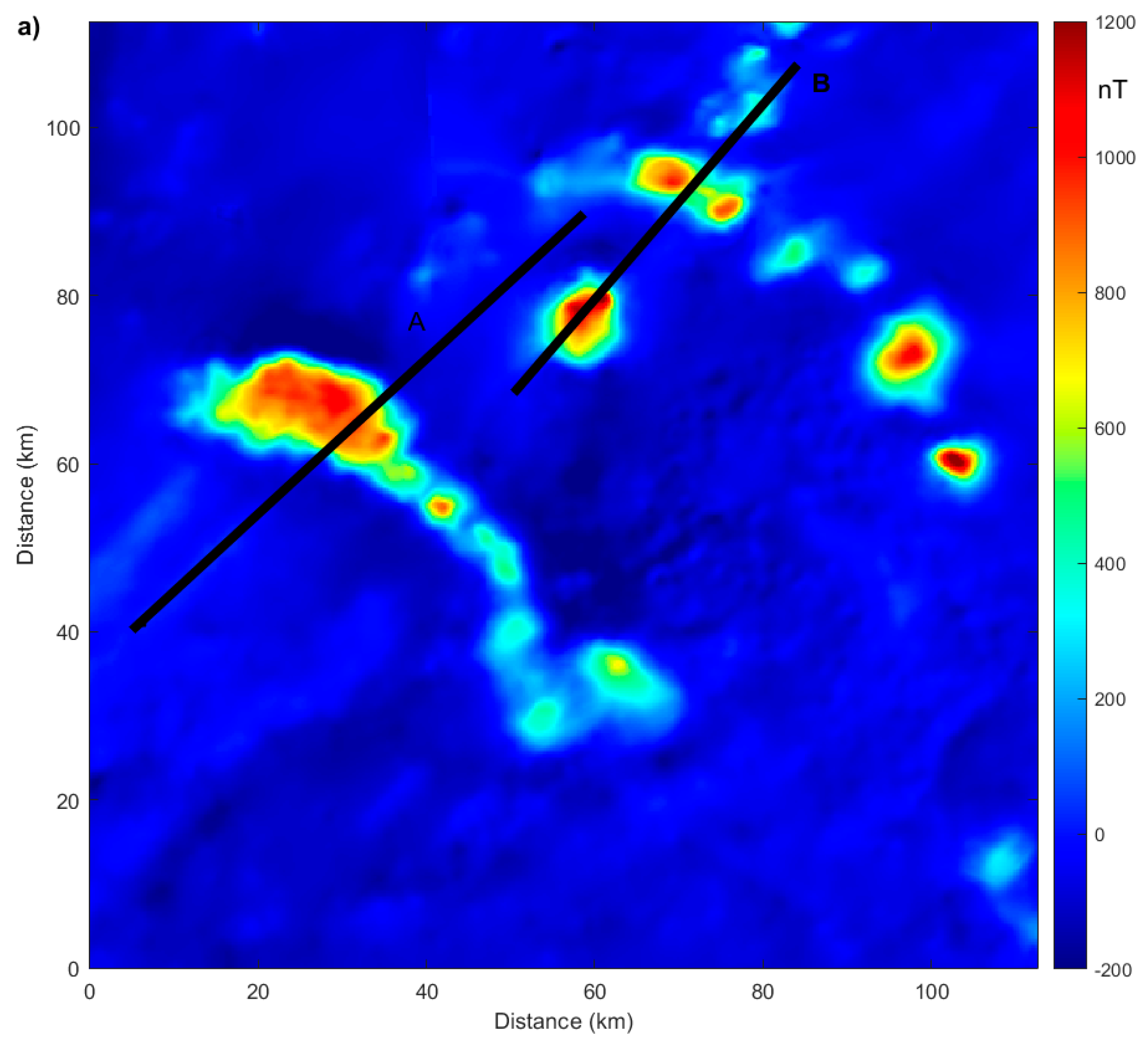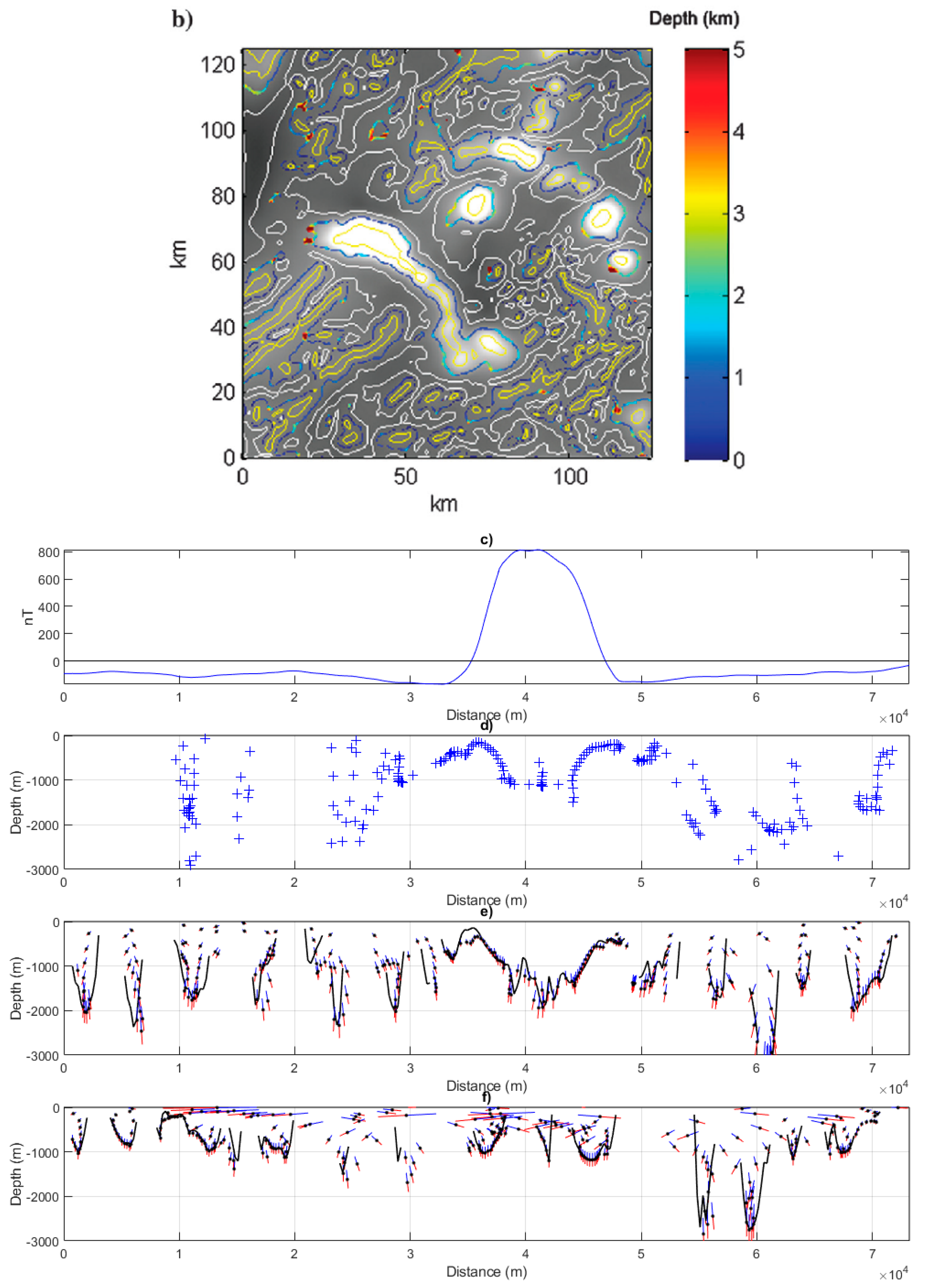Using Euler Deconvolution as Part of a Mineral Exploration Project
Abstract
:1. Introduction
2. Materials and Methods
3. Results
4. Application to a Mineral Exploration Project in Southern Africa
5. Conclusions
Funding
Data Availability Statement
Conflicts of Interest
References
- Fedi, M. DEXP: A fast method to determine the depth and the structural index of potential fields sources. Geophysics 2007, 72, I1–I11. [Google Scholar] [CrossRef]
- Hsu, S.; Sibuet, J.; Shyu, C. High-resolution detection of geologic boundaries from potential-field anomalies: An enhanced analytic signal technique. Geophysics 1996, 61, 373–386. [Google Scholar] [CrossRef]
- Hsu, S.; Coppensz, D.; Shyu, C. Depth to magnetic source using the generalized analytic signal. Geophysics 1998, 63, 1947–1957. [Google Scholar] [CrossRef]
- Keating, P.; Sailhac, P. Use of the analytic signal to identify magnetic anomalies due to kimberlite pipes. Geophysics 2004, 69, 180–190. [Google Scholar] [CrossRef]
- Hartman, R.R.; Teskey, D.J.; Friedberg, J.L. A system for rapid aeromagnetic interpretation. Geophysics 1971, 36, 891–918. [Google Scholar] [CrossRef]
- Cooper, G.R.J. The automatic determination of the location and depth of contacts and dykes from aeromagnetic data. Pure Appl. Geophys. 2014, 171, 2417–2423. [Google Scholar] [CrossRef]
- Cooper, G.R.J. A generalized source-distance semi-automatic interpretation method for potential field data. Geophys. Prospect. 2023, 71, 713–721. [Google Scholar] [CrossRef]
- Huang, L.; Zhang, H.; Sekelani, S.; Wu, Z. An improved Tilt-Euler deconvolution and its application on a Fe-polymetallic deposit. Ore Geol. Rev. 2019, 114, 103114. [Google Scholar] [CrossRef]
- Huang, L.; Zhang, H.L.; Li, C.-F.; Feng, J. Ratio-Euler deconvolution and its applications. Geophys. Prospect. 2022, 70, 1016–1032. [Google Scholar] [CrossRef]
- Reid, A.B.; Allsop, J.M.; Granser, H.; Millett, A.T.; Somerton, I.W. Magnetic interpretation in three dimensions using Euler deconvolution. Geophysics 1990, 55, 80–91. [Google Scholar] [CrossRef]
- Thompson, D.T. Euldph: A new technique for making computer assisted depth estimates from magnetic data. Geophysics 1982, 47, 31–37. [Google Scholar] [CrossRef]
- Mushayandebvu, M.F.; van Drielz, P.; Reid, A.B.; Fairhead, J.D. Magnetic source parameters of two-dimensional structures using extended Euler deconvolution. Geophysics 2001, 66, 814–823. [Google Scholar] [CrossRef]
- Philips, J.D. Two-step processing for 3D magnetic source locations and structural indices using extended Euler or analytic signal methods. In Proceedings of the SEG International Exposition and 72nd Annual Meeting, Salt Lake City, UT, USA, 6–22 October 2002; pp. 1–4. [Google Scholar]
- Cooper, G.R.J. Euler deconvolution applied to potential field gradients. Explor. Geophys. 2004, 35, 165–170. [Google Scholar] [CrossRef]
- Marson, I.; Klingele, E.E. Advantages of using the vertical gradient of gravity for 3-D interpretation. Geophysics 1993, 58, 1588–1595. [Google Scholar] [CrossRef]
- Salem, A.; Ravat, D. A combined analytic signal and Euler method (AN-EUL) for automatic interpretation of magnetic data. Geophysics 2003, 68, 1952–1961. [Google Scholar] [CrossRef]
- Salem, A.; Williams, S.; Fairhead, D.; Smith, R.; Ravat, D. Interpretation of magnetic data using tilt-angle derivatives. Geophysics 2008, 73, L1–L10. [Google Scholar] [CrossRef]
- Pasteka, R.; Richter, F.P.; Karcol, R.; Brazda, K.; Hajach, M. Regularized derivatives of potential fields and their role in semi-automated interpretation methods. Geophys. Prospect. 2009, 57, 507–516. [Google Scholar] [CrossRef]





Disclaimer/Publisher’s Note: The statements, opinions and data contained in all publications are solely those of the individual author(s) and contributor(s) and not of MDPI and/or the editor(s). MDPI and/or the editor(s) disclaim responsibility for any injury to people or property resulting from any ideas, methods, instructions or products referred to in the content. |
© 2024 by the author. Licensee MDPI, Basel, Switzerland. This article is an open access article distributed under the terms and conditions of the Creative Commons Attribution (CC BY) license (https://creativecommons.org/licenses/by/4.0/).
Share and Cite
Cooper, G.R.J. Using Euler Deconvolution as Part of a Mineral Exploration Project. Minerals 2024, 14, 393. https://doi.org/10.3390/min14040393
Cooper GRJ. Using Euler Deconvolution as Part of a Mineral Exploration Project. Minerals. 2024; 14(4):393. https://doi.org/10.3390/min14040393
Chicago/Turabian StyleCooper, G. R. J. 2024. "Using Euler Deconvolution as Part of a Mineral Exploration Project" Minerals 14, no. 4: 393. https://doi.org/10.3390/min14040393




